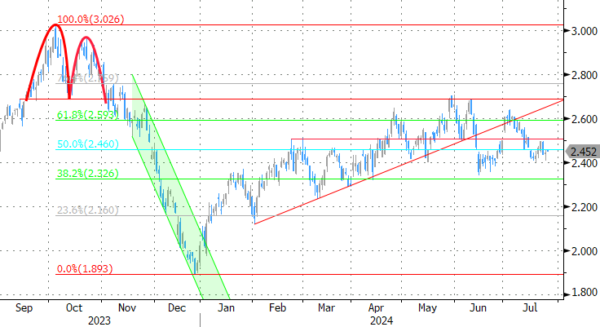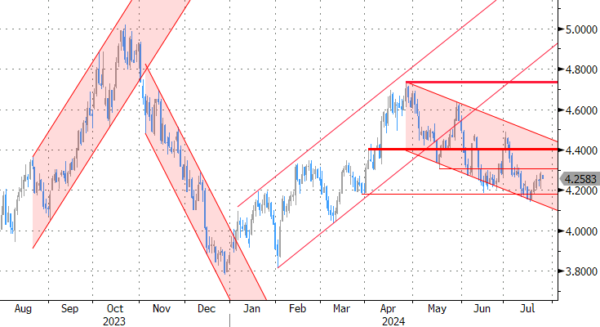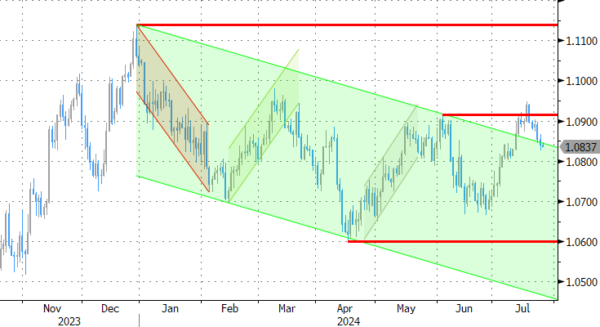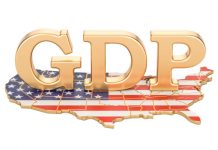Markets
Market focus yesterday initially was on the PMI releases. Later sentiment turned sharply risk-off even as there was no outright link between both storylines. EMU PMI’s (50.1 from 50.9) indicated that activity came to an almost standstill at the start of Q3. This triggered a further dis-inversion/steepening of the EMU/German curve, even as costs/price pressures remain high. The 2-y German yield declined 6.0 bps while long-term yields rose (30-y +2.5 bps). PMI’s in the UK (composite 52.7 from 52.3) and the US (55.0 from 54.8) were better than expected, but yield markets in both countries joined the broader steepening trend. In the US, poor new homes sales also was seen as a pointer that a restrictive monetary policy was weighing on activity that might force the Fed to cut rates rather soon. US 2-y yield declined about 3 bps while the 30-y rose 5.8 bps. Markets are gradually moving to a scenario of the Fed cutting its policy rate by a cumulative 75 bps this year, starting in September. Next to the data, sentiment was further shaped by an outright risk-off positioning after disappointing earnings from some US tech bellwethers. The S&P 500 lost 2.31%. Nasdaq tumbled 3.64%. In this context, one could expect a strong USD, but this wasn’t really the case. The DXY index even declined marginally (104.39), mainly due to sharp outperformance of the yen (USD/JPY close 153.89 from 155.6). The EUR/USD also limited the damage from the poor PMI’s (close 1.084). Remarkable, a new test of the EUR/GBP 0.84 also didn’t succeed, despite a better UK PMI’s, especially compared to the EMU.
Yesterday’s WS risk-off also dominates Asian trading (e.g Nikkei -3.25%). US yields extend their decline. The yen continues its sharp ascent. (USD/JPY 152.7). Later today, the calendar contains German IFO confidence, the first estimate of the Q2 US GDP (including price deflators), US weekly jobless claims and US durable goods orders. Consensus expects annualized Q/Q growth at 2.0% (from 1.4%). We even see an upward risk. Question remains whether a solid growth figure will be enough to change recent market drive pushing for ‘frontloaded’ Fed rate cuts. The US 2-y yield currently is at risk of falling below the 4.40% support. Recently markets were more sensitive to negative rather than positive news. In this respect weaker claims of durable goods orders and a risk-off sentiment also still have to role to play. With respect the FX impact of a risk-off correction, we also look out on the battle for the preferred safe haven between the yen and the dollar. At least for now the former remains in pole position. EUR/USD also shows ‘remarkable’ resilience with next support near 1.08 (50% retracement/early July lows).
News & Views
The Bank of Canada cut its policy rate from 4.75% to 4.5% yesterday. New forecasts showed that excess supply in the economy has increased. Household spending, including both consumer purchases and housing, has been weak and there are signs of slack in the labour market. GDP is expected to grow 1.2% this year, 2.1% in 2025 and 2.4% in 2026. CPI eased to 2.7% in June after increasing in May while the central bank’s preferred measures of core inflation have been below 3% for several months. Additionally, the breadth of price increases is now near its historical norm. The BoC forecasts core inflation to slow further to around 2.5% in 2024H2 and ease gradually through 2025. The path of headline CPI may be bumpy, temporarily dropping below core measures before returning sustainably to the 2% target in H2 2025. The BoC did not offer concrete hints on future cuts other than saying they will be guided by incoming information. Money markets upped their bets for another two rate cuts this year following the one yesterday (97% discounted). The Canadian swap curve turned less inverse with losses at the front of as much as 8.6 bps. These were partially inspired by the general risk-off move though. The Loonie extended the mid-July losing streak which coincided with a sharp oil correction as well. USD/CAD (1.382) is nearing the April highs of 1.3846.
China lowered the rate on its one-year policy loans this morning. The decision was unexpected and unusually large (20 bps, to 2.30%). This first reduction in a year followed Monday’s cut of the 7-day repo rate, which is now transforming into the new reference rate. But just like Monday’s reduction, there’s doubt whether it’ll really move a needle for China’s ailing economy. Demand for the policy loans is low given its high cost relative to market rates, which have come down sharply over the past months. China’s yuan nevertheless strengthened against the US dollar this morning for a second day straight. The move is at least as much inspired by the USD/JPY cross rate though. USD/CNY dropped from 7.2755 at the open yesterday to 7.2518 currently.
Graphs
GE 10y yield
The ECB cut its key policy rates by 25 bps at the June policy meeting. A more bumpy inflation path in H2 2024, the EMU economy gradually regaining traction and the Fed’s higher for longer US strategy make follow-up moves difficult. Markets are coming to terms with that. Meanwhile, much of the save haven bids were reversed after the (first round in) the French elections. The 2.34%-2.4% support zone looks solid.
US 10y yield
The Fed indicated that it needs more evidence to lower its policy rate. June dots suggested one move in 2024 and four next year. Disappointing ISM and back-to-back downward CPI surprises put the US money market back on (at least) two rate cuts this year (September/December). The US 10-yr yield tests the recent lows and the downside of the downward trend channel in the 4.2% area.
EUR/USD
EUR/USD is testing the topside of the 1.06-1.09 range as the dollar loses interest rate support at stealth pace. Markets consider a September rate cut a done deal and only need confirmation from high-ranked Fed officials. In the meantime, the euro got rid of the (French) political risk premium. EUR/USD recently evolved back to a more neutral positioning.
EUR/GBP
Debate at the BOE is focused at the timing of rate cuts. May headline inflation returned to 2%, but core measures weren’t in line with inflation sustainably returning to target any time soon. Still some BoE members at the June meeting appeared moving closer to a rate cut. Labour has yet to reveal its policy plans after securing a landslide election victory. EUR/GBP 0.84 support is being tested.


















